I have a small lot with two large oak trees and I have planted some fruit trees. So there is plenty of shade and leaves to rake. But most of the sunshine I need for my garden falls on my back patio. My solution is container gardening.
In the beginning, we purchased beautiful pots and planted a decorative garden. But now my philosophy is that if it’s not edible or medicinal, I don’t grow it. And I grow in any container available: buckets, dish tubs, and a couple of raised gardens along the fence line.
The Advantages of Growing in Containers
I’ve discovered that you can grow most anything in a container and some crops are actually better off in a container. I can mix the soil to the preference of the crop: a nice acidic soil for my blueberry bushes and a loose sandy soil for root crops like carrots and radishes. Each plant gets the amount of water it needs and they sit next to each other with only a little space between them.
Container gardening makes it easy to plant a few new varieties each season without committing a large amount of space to them. My favorite thing about container gardening, however, is weeding. I get very few weeds in my pots and when I do, they are easily dealt with. I also get fewer pests and soil borne diseases.
What Can I Grow in Containers?
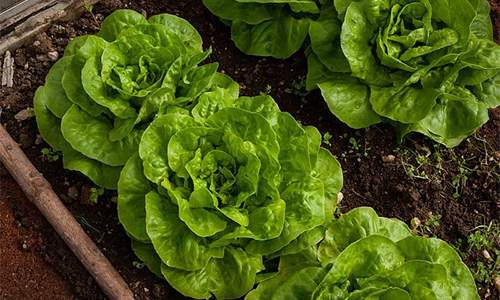
You can grow most everything in containers, but some plants do extremely well with very little care, while others take more attention. I live in Florida, so some of these plants might not grow in your area, but others not listed here will grow in your area. Don’t be afraid to try anything. Let’s start with the easiest to grow.
Leafy Greens like are easily grown in buckets or a dish pan. I like to start them early in the spring and plant them again in the fall with a few staggered plantings along the way. They usually bolt as soon as the weather turns hot, but I can extend the growing season in the winter by bringing them inside on the coldest nights.
Fortunately, we have mild winter weather in my area of Florida, so I can often grow these plants through most of the winter.
Here Are the Greens I Plant in Containers: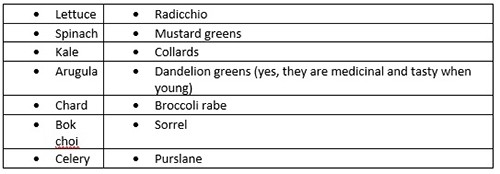
Herbs and Microgreens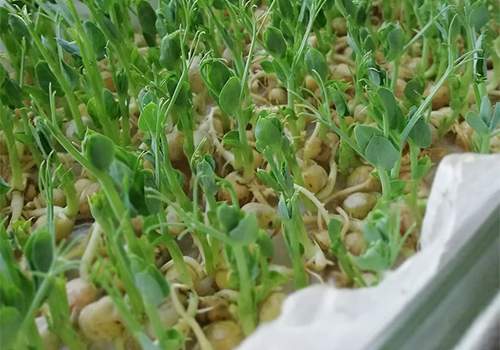
I could never get away with growing watercress in the ground in my area, but it is easier in a container. I just have to make sure it gets the right amount of water and I can enjoy it in my salads most of the year.
Likewise, I grow a nice selection of microgreens and sprouts for my salads including broccoli sprouts, cress, red clover, and spicy salad mix. I grow my microgreens on a shelf on the patio, giving me even more room for the rest of the garden. They get plenty of late afternoon sun there without drying out or burning.
Most of my herb garden also thrives in containers. I like being able to pick whichever herbs I want off the back patio rather than having to plan ahead and make an expensive trip to the store, only to have my supermarket herbs go bad in a few days.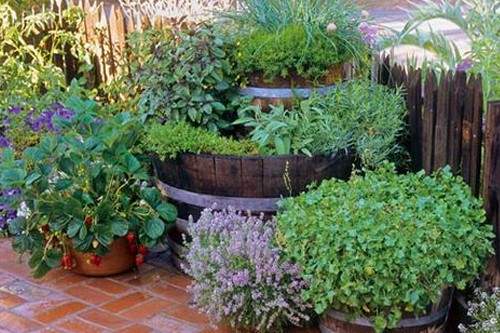 My rosemary bush usually survives year-round in its bucket, but most of my herbs are replanted in the spring and fall. Again, you could bring them in during extreme weather, if you wanted, or bring in a small plant to keep going over the winter. I have a small tower garden that holds most of my herbs and takes up very little space on the patio.
My rosemary bush usually survives year-round in its bucket, but most of my herbs are replanted in the spring and fall. Again, you could bring them in during extreme weather, if you wanted, or bring in a small plant to keep going over the winter. I have a small tower garden that holds most of my herbs and takes up very little space on the patio.
My French tarragon grows fairly well in a six-gallon bucket, but it would probably prefer a larger container. It likes a little more room for the roots. My container garden contains: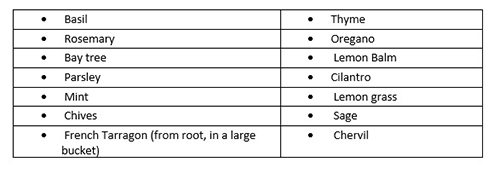
Related: How to Grow Potatoes in Shopping Bags for an Extended Harvest
Vegetable Crops
My favorite bucket plants are peppers and tomatoes. Both do very well in the spring and fall when temperatures aren’t too extreme. Tomatoes won’t set fruit if the daytime temperature is too high and this seems to be more of a problem in containers where the soil is also warmer. However, I can get a little longer season in the spring and early fall by moving the plant to a shady location when the temperatures get too high.
In Florida, because of the humidity, I have always had a problem with powdery mildew on squash, cucumbers, and melons. This is less problematic with container growing because my soil isn’t contaminated in the beginning and I keep the containers on the patio so that they have good drainage and no contact with infected soil. I’ve still had an occasional problem over the years, but not nearly as bad as growing in soil.
One issue with some container grown vegetables is pollination. If you have several pots of tomatoes, there will usually be no problem. But if you only have one tomato plant or one cucumber, or whatever, you might have to hand pollinate. It is easily done with an artist’s brush, but usually the wind or insects will take care of it for you.
For climbing vines like pole beans, cucumber, and some tomatoes, I place them next to the fence or I give them a tomato cage for support.
These vegetables grow well in containers with a little extra care: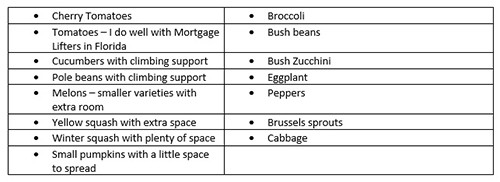
Root Crops That Grow Well in Containers
I’ve tried to grow root crops most everywhere I’ve lived with limited success, usually because of rocky or clay soil. But in a bucket or a deep dish pan, root crops are much more likely to do well because you can control the soil, moisture, and nutrients easily. I don’t grow many root crops, but they do well.
Fruits That Grow Well in Containers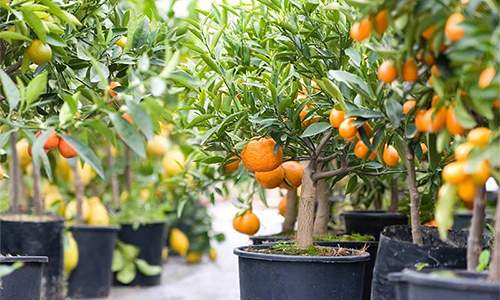
I wish I had planted my original fruit trees in containers, however when we purchased the property, I was anxious to plant and chose spots around the property. I originally planted a mango tree that produces a few fruits for the squirrels, a sour carambola that over produces, and a fig tree that succumbed to the lawn mower. If I had planted them in containers, I would have much better flexibility and more sunny spots for growing vegetables now.
I did learn my lesson, however, and now have quite a few fruits in containers. Surprisingly, these fruits do very well in containers:
An Unusual Success Story
As an aside, I gave my mother a potted lemon tree and a potted kumquat tree which she brought indoors through the winter for the first few years. As they got larger and produced well and outgrew their pots, she decided to plant them outdoors and see how they would do.
Now this sounds natural, knowing that I live in Florida. However, my mother lives in South Carolina, just across the Georgia state line at Augusta. It is much too cold in the winter for these trees, but they are thriving.
The first few years she covered them with sheets during freezes, but once they were established, she started leaving them on their own. Both trees are large now and produce more fruit than she can give away. Don’t be afraid to try growing a plant, even if it normally doesn’t grow in your area.
Related: 10 Bugs You Should Never Kill In Your Garden
Special Care for Container Plants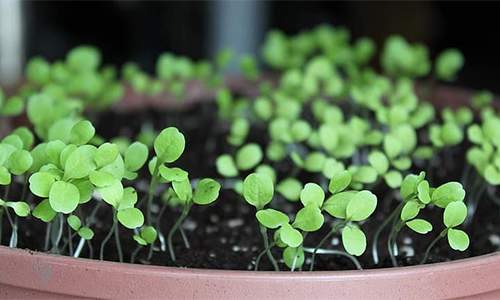
Container plants are a bit different than growing in the ground. A hot day can rob the soil of all moisture very quickly. I make sure my containers have plenty of drainage and I water them regularly. On the hottest Florida days, I drench the soil morning and night. If the plant is beginning to wilt, the leaves are crispy, or the soil is dry, give them water.
Another consideration for container gardens is fertilizer. Your plants need nutrients, especially if you are reusing the same soil every year. There are organic fertilizers available, as well as compost and other nutrients. You need to be aware of what the plant needs and provide it.
Leafy greens need plenty of nitrogen and a bit of the other nutrients. But fruiting vegetables need other nutrients for fruiting. I usually fertilize according to the recommendations for the individual plants. This takes more time but allows maximum yield for each plant.
Container Sizes
Most plants will do well in a 5-gallon bucket or a dishpan, however some plants need more space. Plants with a tap root prefer a deeper container and some need room to spread out. Take the plant growth habits into consideration when planning your garden and choosing the container.
Save the Seed Envelope
If you buy plants, read and save the tags. For seeds, I usually file the seed envelope for later consultation. Label your container with a stake that indicates what you planted and when in a permanent marker or paint. It is easy to forget after a few weeks have passed and all the leaves look alike.
You may also like:
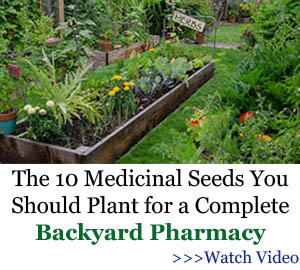 10 Beautiful Plants That Are Secretly Killing Your Garden
10 Beautiful Plants That Are Secretly Killing Your Garden
75+ DIY Projects For a Self-Sufficient Homestead (Video)
The Three Sister Garden Plans: How To Get The Most Out Of Every Square Foot

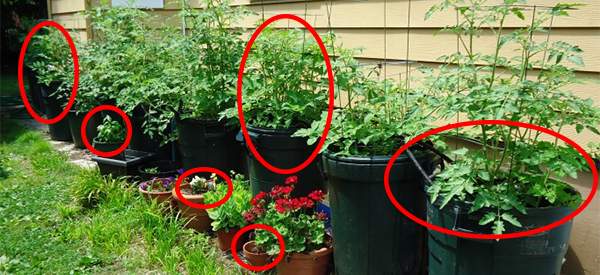













To make the most of the limited growing space I have, I have been doing perennial/annual herbs and some tasty veggies in pots, planters and window boxes for many years. In the city it is important to control your soil. You do not know what your neighbors may be doing. Each year I do a little research and add something new, but alas I’ve run out of room! So this year I planted mail-order Prussian Heirloom hops from a grower in MI. Looking up, I found had lots of space and plenty of sun over the south facing back porch. Since I only buy heirloom plants/ seeds, finding an heirloom root for me was kind of special! Now I am researching how to brew beer!
Mushrooms, checkout Youtube
I am glad someone else sees the advantages ot growing in containers I have been doing it for over 10 years now. I have not tried any fruits yet but now that I know they will grow I will.
Great article for those of us who have a dark brown thumb. If you want a plant to die, let me care for it. I need all the help I can get just to get dandelions to grow.
With a light mustard vinaigrette, that makes a delicious side salad! Nutritious too!
I’ve been attempting to grow in containers for a couple of years. Keeping up with watering can be a real challenge if you don’t have an external hose connection, as is the case for many apartment dwellers. My best suggestion for that is to get a couple of empty water bottles of the kind that fits in the top of a cooler. Fill it using the kind of hose that attaches to the faucet for washing your dog or your hair. The hole in the top of the bottle is small enough for watering without drowning your plants. Depending on how much sun they get, you may have to water 2x daily during hot spells.
I grow herbs in containers and like to scatter a few pots of peppers and tomatoes in my butterfly gardens, they always seem to outperform the ones in my vegetable garden. I see a lot of my neighbors building tables and plant stands to get their container plants up to waist high, that’s a good idea, I can still bend at the waist and put my palms on the ground but need a cane if I’m going to bend my knees. People use hay bales as containers,too, I’ve always been meaning to try that. I’m going to grow heritage pintos in pots next year and let them climb the fence. I grew heritage German Butterball potatoes in my garden this year, I think they’d produce well in a 5-7 gallon container, I got about a dozen small and medium taters per plant and it is the best potato we’ve ever had.
Great info! This I have to try! I’ve been thinking of adding a root vegetable crop that would do well around here. Long Island,NY use to be nothing but potato fields and rows of cabbage. Two things that keep well and are very versatile. Hugelkulture German Butter ball potatoes will be a great addition to my tiny plot of paradise! Thank you very much!
Diane, thank you. Sweet potatoes do well in a container. Kumquats can handle down to 15 F, and one in KC U had a freeze at 0 and survived. Some oranges are better than others, but most do well in my area, Zone 9 A.
this year, thanks to the Bighorn fire, I’m raising thrashers and quail, not a garden. The only thing to do well is sweet potatoes in 20 and 30 gallon tubs. I packed mulch (leaves and twigs and a lot of weeds) in each tub, then covered with a few inches of soil. Soaked it good and let it go till it started to decay. One or two slips in each tub, and they were off. Two eggplants are potted, two good chilis (chimoyo, which like cold weather), and one in the ground survived the birds.Good soil and enough water and they nothing minds the heat too much. I just hope the hops vine will. Happy gardening. niio
This is downright inspiring! Thank you!
This is a great and informative read. You all should be glad you can plant or have containers outside! In our condo we are not allowed to have anything at all outside. Two years in a row I have planted in containers on my back Lanai, Every container ends up with bugs! (Sugar ants,Fungus Gnats ETC) Yeah I can use Neem oil and whatever, but, takes all the fun out of gardening Might want to touch on the subject of bugs on inside containers.
Safer Soap insecticidal soap is a great organic for all gardening, indoor and out. Non burning on just about everything but, if I remember right, it will burn palm trees, the best spray for aphids and mealy bugs. All seasons type oil spray for spider mites and hard scale. Fungus gnat larvae live in the top 1/8 inch of soil, let the soil of infested plants dry between waterings and stir up that top 1/8th inch of soil regularly to end fungus gnats (little boogers land on my Kindle screen when I read in the dark!).
Mike: aphids are a sign of too much nitrogen, niio
We are quite friendly with some organic orchardists (an elderly couple). They use Shaklee’s Basc H, double strength, to keep bugs/worms away from their apple trees with great success. I asked about fungus diseases, as they abound in this are of Central New York. They said, if the apples are not yellow or green, then you can use Sulfur. If they are, then you may have to try copper spray to keep fungus down. Hopes this helps someone!
There are lots of ways to grow in containers. I started years ago in 5 gallon buckets after becoming enthused over what some young boys (more like young men now) were doing. http://www.globalbuckets.org This year is the last year for some of my buckets, they are succuming to the Central Califoria heat and next planting season I plan on moving to grow bags in conjunction with soil block seedlings to plant in them. Grow bags are similar to buckets, but provide more air to the roots through the sides of the bags.
Sorry for the typos in my comments! JESS
Someone should produce a video & booklet etc. listing the plants and the soil etc. particulars for each grow region to make it easier.
I personally would pay a small fee for it.
Have you ever thought about watering your plants that you’re nurturing in order to grow healthy organic food by using a hose with LEAD in it! Everyone remembers drinking from such a hose when outside in the summer, right? We didn’t know better. We hear about avoiding lead in our drinking water, lead being especially harmful for children. I have just started researching how plants absorb lead in soil and how it goes into the edible parts. Of course some lead is naturally part of soil but when we add more it stays in the soil and can become unhealthy. I discovered that lead free hoses are bought for RVs for bringing in drinking water. I had been watering my few tomato plants with a gallon drinking water container bought at the store! Then I saw that Amazon was selling lead free garden hoses in different lengths for not too much more than regular hoses.
I have citrus trees in the large plastic tubs ranchers feed molasses to their cattle. They are 10 gal or larger. I drill 3/8 in holes app 4″ above the bottom as a water reserve. I add rocks or bricks, or pea gravel to the top of the holes. I add Soil Moist to the soil I fill the pot with. Pineapples I grow in 5 gal buckets or kitty litter buckets using the same technique.